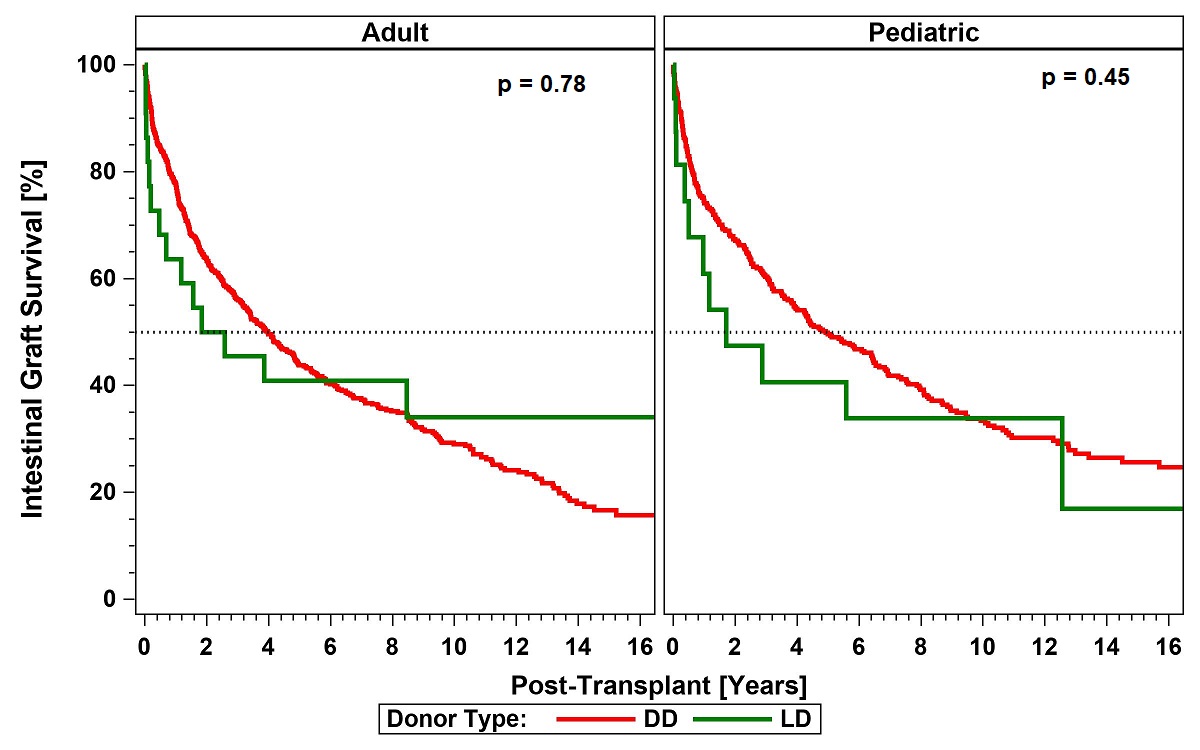25 Years of a Standardized Living Donor (LD) Intestinal Transplant Technique – What Has Been Achieved?
1SUNY Downstate Medical Center, Brooklyn, NY, 2SUNY Downstate Medical Center, Brooklyn, MA
Meeting: 2022 American Transplant Congress
Abstract number: 348
Keywords: Intestinal transplantation, Living donor, Outcome
Topic: Clinical Science » Small Bowel » 66 - Intestinal Transplantation and Rehabilitation
Session Information
Session Name: Intestinal Transplantation and Rehabilitation
Session Type: Rapid Fire Oral Abstract
Date: Monday, June 6, 2022
Session Time: 5:30pm-7:00pm
 Presentation Time: 6:30pm-6:40pm
Presentation Time: 6:30pm-6:40pm
Location: Hynes Room 206
*Purpose: The indication for intestinal transplantation (ITX) is irreversible intestinal failure with dependence on total parenteral nutrition (TPN). Most intestinal transplants are from deceased donors (DD). However, LD ITX has advantages including elimination of waiting time, elective/pre-emptive surgery, shorter cold ischemia time, lower rejection rate and better HLA matching. It was not until 1997 that a standardized, safe, and successful surgical technique for LD ITX was introduced. The goal of this study was to investigate outcome and future application of LD ITX.
*Methods: A total of 85 LD intestinal transplants have been performed worldwide, 50 of them in the United States. Notably, there were only biological donors. The key principles of the 1997 standardized surgical technique for ITX are: (1) procurement of 180-200 cm of distal ileum in adults (about 60-150cm for pediatric recipients based on age and weight), leaving > 65% of small bowel in the donor; (2) the terminal ileum (30-40cm of the most distal ileum), the ileocecal valve, and the cecum remain with the donor to not interfere with B12-absorption, bowel transit time and bacterial flora; (3) the vascular pedicle comprises the ileocolic vessels or the terminal branches of the superior mesenteric vessels; the right colic artery is preserved; (4) bowel continuity after resection is immediately restored.
*Results: Patient and graft survival rates are available for primary US cases only (22 adult, 16 pediatric ITXs). For adult LD ITX recipients, 1- and 5- year graft survival rates were 64% and 41%, for pediatric transplant recipients 60% and 34%. There were no significant differences in patient and graft survival rates between LD and DD ITX. A major advantage of LD ITX has been that it was pre-emptively performed in some patients with advanced, but still reversible, TPN-induced liver disease, thus reducing the wait-list mortality for combined DD intestinal and liver transplants. 1-year graft survival for U.S. recipients of the combined procedure was 57% and there were no donor complications in any of the procedures.
*Conclusions: (1) The standardized surgical technique for LD ITX introduced 25 years ago is safe and reproducible; (2) Recipient outcome (patient and graft survival) is not different for LD vs DD ITX; (3) No donor deaths or major donor complications have been reported; (4) Solitary LD ITX can be performed preemptively and reverse TPN-induced liver fibrosis; combined LD intestinal and liver transplant is a life-saving procedure; (5) LD ITX is a rare, but underused treatment modality for intestinal failure.
To cite this abstract in AMA style:
Gruessner R, Gruessner AC. 25 Years of a Standardized Living Donor (LD) Intestinal Transplant Technique – What Has Been Achieved? [abstract]. Am J Transplant. 2022; 22 (suppl 3). https://atcmeetingabstracts.com/abstract/25-years-of-a-standardized-living-donor-ld-intestinal-transplant-technique-what-has-been-achieved/. Accessed December 19, 2025.« Back to 2022 American Transplant Congress

